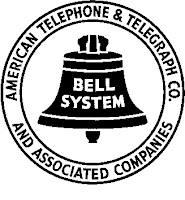 |
| DeArmond Trem Trol 800 |
By the 1950’s some guitar amplifiers, such as Fender, Ampeg, Magnatone, and Danelectro included tremolo, and reverberation. Magnatone amps included real frequency modulation vibrato.
In the mid 1950's amplifier designer Ray Butts offered his EchoSonic amplifiers. These amps had an adjustable magnetic tape loop built into them that allowed the player to achieve an echo of the note they had just played.
In 1959 sound engineer Mike Battle created a stand-alone tape loop unit that he called The EchoPlex which he distributed through Maestro.
 |
| Early Bell Telephone logo |
Oddly enough, The Bell Telephone Company designed their telephones with a compression circuit so that no matter how soft or loud a person talked, or even screamed, into the receiver, the signal would not diminish, and the decay would be amplified. Recording engineers picked up on this feature to maintain a smooth sound.
Maestro was also the first company to produce a Fuzz effect. This led to Overdrive, and the Distortion pedal that are produced by so many varied companies.
Aside from Maestro, as I recall one of the first companies to offer guitar effects was Electro Harmonix. Some of their initial offerings were plug in units that went directly into the guitar such as the LBP-1, while others were floor pedals.
 |
| 1968 Jordan Boss Tone |
A company called Jordan offered a small box with silicon transistors that plugged right into a guitar called The Boss Tone.
As the years passed, so many different and unusual pedal were produced by companies such as Boss, DOD, Maxon, Dunlop, Ibanez, MXR, Yamaha, Line 6, Tech 21 and on and on.
 |
| Mooer Audio |
Unlike most of their predecessors, which required an internal battery, these units were too tiny, so they needed a power adapter. I first saw these tiny units on display at a local Guitar Center.
 |
| Bjorn Juhl |
In the case of Donner pedals that are sold directly or through Amazon, there isn’t much to investigate.
In the scheme of things, they are only getting started, but they are making progress in making music more accessible.
Are Donner pedals any good? Well, they are very inexpensive. You can’t go wrong with reasonable costs, great ratings across the board, and starter kits aplenty. It’s a shame that not much is known about this new effects and guitar manufacturer.
It's very likely that Donner, and other companiesTC electronic, Wampler, Maleko, Ibanez Azor, Rowin, Mooer, Ammoon pedals and others are all made by the same factory, which is more then likely Shenzhen, since most of their product ranges seem to be rebranded versions of the others.
Usually if the only difference in the pedals is the brand name then it's safe to assume that it's the same pedal and made by the same factory.
Based on the facts that many, many US companies have Chinese and Indonesian manufacturers build their products. This includes Squier, Gretsch, Epiphone, and many other brands. This is known as White Labelling. This has been a common practice with many manufacturers. They see a niche, buy products in bulk and put their own brand name of the product.
 |
| Mini Guitar Pedal Board |
The first time I ran across these tiny guitar pedals was five or six years ago at a Guitar Center. Someone had traded in a pedal board that had around a dozen of these little pedals.
My first thought was how to you press down on the buttons, since they were so close together, without stepping on more than one pedal? I wear size 11 shoes and wouldn't want to crush the little things or turn on more effects than I want to.
Despite their size, the pedals seem to deliver the proper sound. I have only tried out the compressor and the RevEcho pedal and I must say the get the job done.
One unique pedal is the Donner Circle Looper Guitar Pedal with Drum Machine Time Display. For $120 you have your own veritable band.
Most of the pedals are priced between the forty to seventy dollar range, except for the $300 Arena 2000 Multi-Effect Guitar Pedal Amp Modeling Modeling Processor.
So how do these pedals sound? In my opinion, for a little money you get a lot of great sounds. Through the past few years, I have seen an increased interest in these pedals.
In my opinion they sound great! Due to their small size, if you wear big ol' clod bustin' stompers, you probably need a larger pedal. (Doesn't Donner, Moorer, Rowin, and More sound like a law firm? 😁)
















